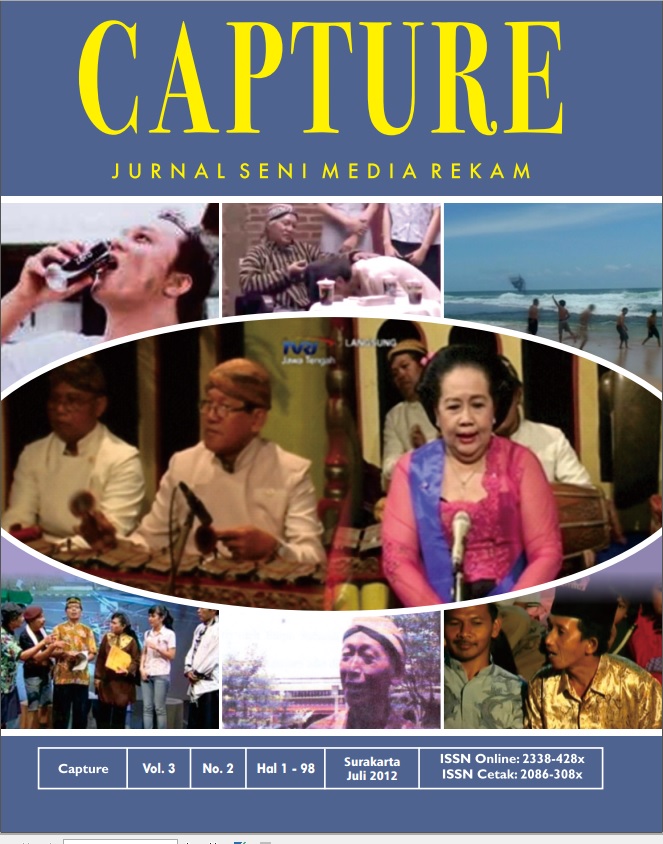PENERIMAAN KHALAYAK DESA PONGGOL MAGELANGTERHADAP PROGRAM GENDU-GENDU ROSO GRABAGTV
DOI:
https://doi.org/10.33153/capture.v3i2.1891Abstract
GrabagTV is one of community televisions that has been operated in Indonesia.It wasestablished in 2004 in District Grabag, Magelang regency, Central Java. Grabag TV is noncommercial television. One of programs that aired is Gendu-Gendu Roso.This program is an
interactive dialogue aimed as a space to accommodate the aspirations of the people Grabag.
This problem is then focused on how the public acceptance of the program Gendu-Gendu Roso
as a medium channeling the aspirations of the people in accordance with the goals and ideals of
Indonesia broadcasters.The purpose of this study is how the reader understand on how the
public acceptance of the program being broadcasted on television community and the factors
that affect the acceptance of the audience. This thesis using qualitative methods and the
approach used is reception analysis.This approach is used in order to determine how audiences
receive the contents of the messages conveyed by the media viewed from a variety of
contextual factors that influence.Audience acceptance will be obtained by a long process that
became valuable experience within the public and shaping the mindset and worldview different.
The results of this study show that community acceptance of Gendu Gendu Roso in defending
freedom of speech in the category dominant reception where the community agreed that the
event was able to become the voice of the container,as well as public acceptance of the use of
setting events are also included in the reception dominant. While the acceptance of the
audience to the information included in the reception is dominant and negotiated.The last
discussion on the use of regional languages in the event showed that the acceptance of the
audience entered the reception is dominant,negotiated and oppositional.For people who fall
into the category of oppositional means that the use of the local language cannot be received
well.Public acceptance of the programs shown on television was not the same community.It is
influenced by various factors in daily life such as social background, occupation, age, sex and
neighborhood audiences.
Keywords: Community television, audiences positioning, and Grabag TV
Downloads
References
Ahmad Rosyadi. 2002. Studi Respon Masyarakat Terhadap Televisi
Komunitas AMTV di Desa Palampitan Kecamatan Amuntai Tengah
Kabupaten Hulu Sungai Utara. Skripsi tidak diterbitkan. Universitas
Muhammadiyah Malang.
Burton,Graeme.2007.MembicangkanTelevisi. Jala Sutra:Yogyakarta.
______. 2008. Yang Tersembunyi di Balik Media. Yogyakarta & Bandung: Jala Sutra.
Elvinaro Ardianto. 2005. Komunikasi Massa Suatu Pengantar. Bandung: Simbiosa Rekatama Media.
Fred Wibowo. 2007. Produksi ProgramTelevisi. Bandung:Remaja Rosda Karya.
H.B Sutopo. 2006. Metodologi Penelitian Kualitatif (DasarTeori danTerapannya Dalam Penelitian). Surakarta: Universtas Sebelas Maret Press.
Hikmat Kusumaningrat. 2007. Jurnalistik Teori dan Praktik. Bandung: Remaja Rosda Karya.
Himawan Pratista. 2008. Memahami Film. Yogyakarta:Homerian Pustaka.
Koentjaraningrat. 1990. Pengantar Ilmu Antropologi.Jakarta:Rineka Cipta.
Marselli Sumarno.1996.Dasar-dasar Apresiasi Film.Jakarta:Grasindo.
Masduki. 1989. Radio Siaran dan Demokratisasi.Yogyakarta:Jendela.
Morissan MA. 2008. Manajemen Media Penyiaran. Jakarta: Prenada Media Grup.
Onong Uchjana.1993.Televisi SiaranTeori dan Praktek.Bandung:Mandar Maju.
Pawito. 2007. Penelitian Komunikasi Kualitatif. Yogyakarta:Lkis.
Ruedi Hoffman. 1999. Dasar-Dasar Apresiasi ProgramTelevisi.Jakarta:Grasindo.
Storey, John. 2008. Cultural Studies dan Kajian Budaya Pop.Yogyakarta:Jalasutra.
Tri Nugroho Adi. 2008. Identitas Kultural dan Televisi Lokal (StudiTentang Konstruksi dan Representasi Identitas Kultural
dalam Tayangan Banyumas TV). Tesis tidak diterbitkan.Universitas Negeri Sebelas Maret Surakarta.
Totok Sumaryanto. 2007. Pendekatan Kuantitatif dan Kualitatif dalam Penelitian Pendidikan Seni. Semarang: UNNES PRES:.
Umar Kayam. 1999. Ketika Orang Jawa Nyeni. Yogyakarta: Galang Press dan YayasanAdi Karya.
Wawan Kuswandi. 1996. Komunikasi Massa (Sebuah Analisis Media Televisi). Jakarta:Rineka Cipta.
Williams, Raymond. 2008. Televisi.Yogyakarta: Resist Book.
Hartanto.“Peran StrategisTelevisi Komunitas Dalam Pemberdayaan Masyarakat†dalam Dewa Ruci, Jurnal Penciptaan Seni,Vol. 6,No.2,Juli 2010.
Ido Prijana Hadi.“Penelitian Khalayak dalam Perspektif Reception Analysis†dalam Jurnal ilmiah SCRIPTURA,Vol. 2,No.1,
Jurusan Ilmu Komunikasi, Fakultas Ilmu Komunikasi, Universitas
Kristen Petra,Januari 2008.
http://www.pewar ta-kabar indonesia.blogspot.com/ diakses pada 10 September 2010.
http://www.kpi.go.id/download/regulasi/UU No.32 tahun 2002 tentang penyiaran diakses pada 10 September 2010.
http://www.grabagtv.blogspot.com diakses pada 25 September 2010.
www.facebook.com/GrabagTV diakses 25 September 2010.
http://www.puslit.universitaspetra.ac.id/communication diakses pada 23 Pebruari 2011.
http://www.wikipedia.com/komunikasi diakses pada 19 Mei 2011.
http://www.facebook.com/kickandy diakses pada 6 Juni 2011.
http://www.mediakita.blogspot.com diakses pada 6 Juni 2011.
Narasumber:
Hartanto, dosen, pendiri Grabag TV,
Magelang
Maryoso, produser Gendu-gendu Roso,
Magelang
Dewi,pengurus GrabagTV,Magelang
Downloads
Published
Issue
Section
License
Copyright (c) 2019 Reni Diyah Yulita, Fitri Murfianti

This work is licensed under a Creative Commons Attribution-ShareAlike 4.0 International License.
Copyright
Authors who publish with Capture: Jurnal Seni Media Rekam agree to the following terms:
- Authors retain copyright and grant the journal right of first publication with the work simultaneously licensed under a Creative Commons Attribution License (CC BY-SA 4.0) that allows others to share the work with an acknowledgment of the work's authorship and initial publication in this journal.
- Authors are able to enter into separate, additional contractual arrangements for the non-exclusive distribution of the journal's published version of the work (e.g., post it to an institutional repository or publish it in a book), with an acknowledgment of its initial publication in this journal.







